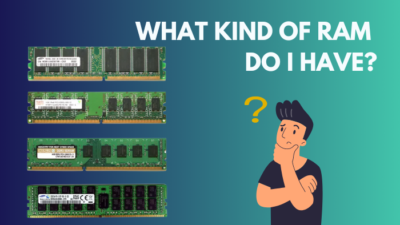Did DDR5 RAM grab your attention and make you contemplate whether you should get DDR4 or DDR5 RAM?
The latest DDR5 RAMs introduced by JEDEC (Joint Electron Device Engineering Council) in 2021 promised some performance features that make them seem like a huge upgrade from DDR4 RAMs.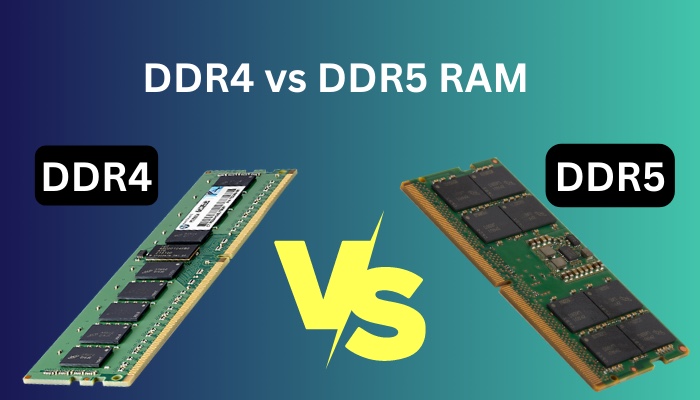
Are you getting your money’s worth if you buy a DDR5 RAM now? Do you need the boost in performance that it has to offer?
If you have these questions in mind, they will be answered very soon after an explanatory comparison has been made between the two types of RAM in this guide. So, stick to the end to learn about the distinctions between DDR4 and DDR5 RAM and whether or not you should get a DDR5 RAM.
What Are The Differences Between DDR4 and DDR5 RAM?
DDR5 RAMs have been introduced along with some improved performance features to DDR4 RAMs. These improvements are made in the capacity, bandwidth, voltage consumption and management, internal architecture, etc. Even then, DDR5 RAMs also have some challenges to overcome.
DDR4 RAMs have been around for a long time and are still very popular in the market. Although DDR5 has been specced to be better than DDR4, it still has some shortcomings.
A comparison between DDR4 and DDR5 RAMs considering different factors is presented in this section. Through them, you will learn about the areas where DDR5 RAM excels and the impediments it has to address to conquer the RAM market.
Here’s the comparison between the specs and other factors of DDR4 and DDR5 RAM:
1. Bandwidth
The bandwidth of a RAM determines the rate of data transfer. DDR4 RAMs clock rates from 800 MHz – 1600 MHz. Since it is a “double data rate” (DDR) RAM, the actual data transfer rate of DDR4 is 1600 MHz – 3200 MHz. This is usually displayed on the labels when advertising the RAM.
The range of data transfer of DDR4 can be increased to around 3600 MHz speed by overclocking your device.
DDR5 RAMs offer a significant increase in the data transfer rate. DDR5’s bandwidth range starts where DDR4 ends. Most DDR5 RAMs start at 4800 MHz and go up to 8400 MHz. This is a prominent upgrade from DDR4.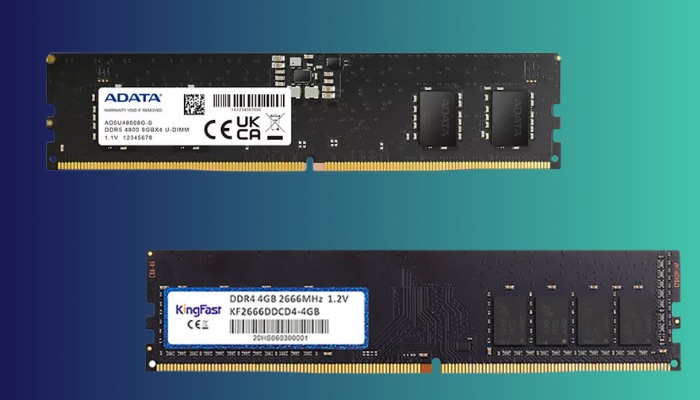
Check out our recent article on is ADATA RAM good.
2. Memory Capacity
The recently introduced DDR5 RAM offers a much higher capacity than that of its predecessor, the DDR4 RAM.
DDR4 technology only allows 16-gigabit memory chips, whereas it is quadrupled to 64-gigabit in DDR5. So, DDR5 can offer a lot more memory space, topping out at 512 GB or even more. In reality, the most feasible DDR5 options in the market give you 128 GB of memory space because there aren’t many devices that can support any higher than that. Yet.
Even then, 128 GB is still a big jump from the meager 16 – 32 GB commonly offered by DDR4 RAMs.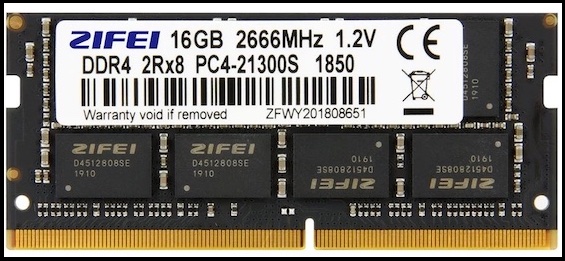
3. Channel Architecture And Performance
DDR4 RAMs operate by a single 64-bit channel (total 72-bit counting ECC). In contrast, DDR5 RAM has two 32-bit channels (40-bit counting ECC) that are independent of each other. Moreover, DDR5 burst lengths have been doubled to 16 bytes from 8 bytes of its predecessor.
The new and improved architecture in DDR5 allows for faster and more efficient data access than DDR4.
Here’s a complete guide on why is only half of my RAM usable.
4. External Pin Arrangement
DDR5 RAMs have the same number of pins as DDR4, but the layout of the pins around the notch is different. In DDR4, the notch in the module is in the middle. On the other hand, DDR5 modules have the notch shifted a bit to the left.
The change in notch position can be helpful for inexperienced users trying to understand the right direction of slotting in their RAM.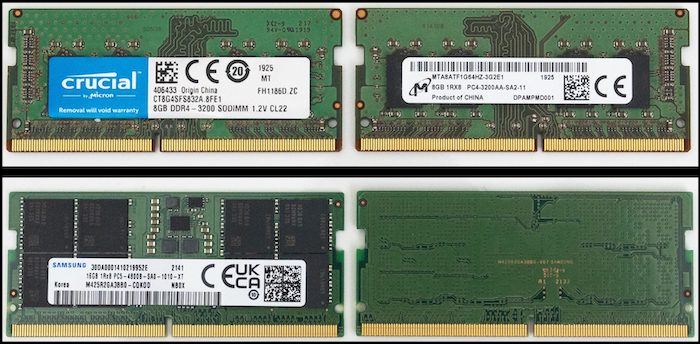 The pins are arranged accordingly around the notch, so it is obvious that DDR4 and DDR5 have different pinout configurations. This makes them physically incompatible with each other. You cannot use DDR5 RAM in a DDR4 slot, and vice versa.
The pins are arranged accordingly around the notch, so it is obvious that DDR4 and DDR5 have different pinout configurations. This makes them physically incompatible with each other. You cannot use DDR5 RAM in a DDR4 slot, and vice versa.
5. Voltage Consumption
DDR5 technology is more power efficient, as it operates at a voltage of 1.1 V. This is lesser than the operating voltage of DDR4, that is, 1.2 V. Although this can reach higher numbers if you overclock your memory device, DDR5 will still operate at a lower voltage than DDR4.
But before that, go through our epic guide on black screen after installing new RAM.
6. Power Management
DDR5 memory has PMIC (Power Management Integrated Circuit) on the module, which regulates the power it receives from the motherboard. Basically, it is an onboard power management system on the module itself.
This is not the case for DDR4 memory. It has no PMIC. Rather, the responsible circuitry to manage the voltage input is on the motherboard. The power management for DDR4 has to be carried out by the motherboard.
7. Thermals
You may assume that better power efficiency means less heat production, but that is not the case for DDR5.
Due to the continuous high performance and denser memory chips, DDR5 RAMs get much hotter than DDR4. For this, you need to have a suitable cooling solution for your memories if you are running DDR5 RAMs in your system.
8. Cost And Availability
As you can imagine, DDR5 memories come with a much higher price tag than DDR4 memories. If you want to get a DDR5 kit, you will have to pay more than double the price you would have to pay to get a DDR4 kit from the same manufacturer with a similar memory capacity. Moreover, not many DDR5 kits are available in the market, so the price is naturally higher.
If you want to get DDR5 RAMs, you must be prepared to part with an extra amount of bucks or wait until they become more available and the price decreases.
9. Compatibility
Currently, DDR4 beats DDR5 when it comes to compatibility, as there aren’t many motherboards and CPUs that support DDR5 memory technology. DDR4 is more widely used in older models of motherboards.
Unless you have a 12th or 13th-generation Intel processor or AMD’s 7000-series processor and a compatible motherboard, you won’t be able to use DDR5 RAM in your system.
With the advent of time, more devices with DDR5 compatibility will start to rise.
Go and check our other article on can I use two different brands of RAM.
Should You Get DDR4 Or DDR5 RAM?
When DDR4 technology was introduced, DDR3 was still relevant for a few years until it started becoming obsolete. So, chances are, DDR4 will be widely used even after DDR5 has been released in the market. Unless you want a future-proof system, you can stick to using DDR4 memory on your computer.
For gaming, DDR4 RAMs are more than capable enough of giving you the best experience. DDR5 kits are overkill for gaming builds.
DDR5 has some great advantages regarding performance, but considering its scarcity in the market, high price and incompatibility with current devices, you are well off with DDR4 memory.
If you are running an older processor, you will have to get a new one and a motherboard compatible with DDR5 technology.
You should only get DDR5 RAM if you run specific tasks on your system that have an intense workload. In these cases, DDR5 memory can give you a huge boost while performing your tasks. Moreover, if you want to build a system that you can use for a good number of years into the future, you should get DDR5 memory for it.
Conclusion
Technology is ever-changing and always upgrading. DDR4 memories introduced after DDR3 have been here for a while, and now DDR5 is taking its place.
This doesn’t mean that DDR4 is going to be completely replaced immediately. It will still be in use for many years to come. Right now, getting a DDR5 memory is more of a luxury than a necessity. The smart thing is to wait it out and aim to build a system with DDR5 memory after it has become more available and optimized.
Even then, if you are confused about which memory to get, look at the comparisons between DDR4 and DDR5 memory from this guide and decide for yourself.
Then again, nobody’s stopping you from getting DDR5 memory for your computer if you have the cash for it.
